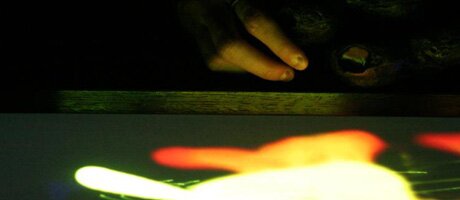We create meaning through actions visible to others and from others' actions. Tangible systems are well-suited to explore and exploit the ways that people draw from prior experience, social cues, and situational context to render their interactions meaningful in their particular situation. Parazoan explores the embodied processes of communication, collaboration and understanding.
Parazoan consists of a set of three biomorphic physical objects (referred to as "parazoans"), and the digital content they are coupled with. The parazoans are made of a custom-built silicone casing, covering an embedded microcontroller and a vibrating motor. The unusual curvilinear shape of the parazoans resembles a game controller and facilitates two-handed interaction, yet also evokes the features of a living creature or an anatomical component. Each vibrates when brought close to another parazoan. A central table display shows real-time, moving ribbons of color based on how participants tilt, shake, move and manipulate the parazoans.
We conducted qualitative video analysis of this system. We observed that participants typically progressed through phases of interaction with Parazoan that could be broadly characterized as exploratory and instrumental. Mutually observable body-actions helped participants develop an understanding of Parazoan, while their ability to interact instrumentally with the system enabled and was reinforced by others' interpretable actions on-screen.

